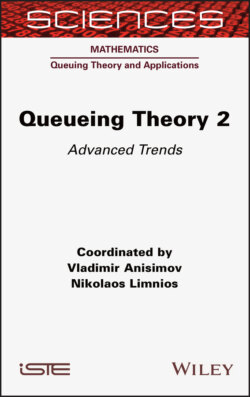Читать книгу Queueing Theory 2 - Nikolaos Limnios - Страница 18
1.7. Discrete-time queueing system with interruptions and preemptive repeat different service discipline
ОглавлениеHere, we consider the system with interruptions described in the previous section for the discrete-time case. The moments of breakdowns and moments of restorations for the ith server satisfy [1.12]. The input flow X is an aperiodic discrete-time regenerative flow with rate λX.
We consider the preemptive repeat different service discipline that means that the service is repeated from the start after restoration of the server and the new service time is independent of the original service time (Gaver 1962).
To define the process Yi for the ith server in the auxiliary system S0, we introduce the collection of independent sequences consisting of iid random variables with distribution function Bi. Of course, we assume that Let be the counting process associated with the sequence be the number of cycles for the ith server during [0,t], i.e. Then the process Yi is defined by the relation
[1.15]
and We denote by Hi(t) the renewal function for
LEMMA 1.2.– There exists the limit
The proof easily follows from the evident inequalities
where the strong law of large numbers and convergence
From lemma 1.2, we have
[1.16]
We introduce the counting processes
CONDITION 1.8.– The counting processes are aperiodic.
Then Y is a regenerative aperiodic flow with points of regeneration
In other words, is a point of regeneration of Y if all the servers get out of the order simultaneously at this moment. Taking into account condition 1.8, we conclude from lemma 1.1 that Now we construct the sequence of common points of regeneration for processes X and Y with the help of [1.3]. Because of lemma 1.1 and the traffic rate ρ of the system is defined by [1.7].
COROLLARY 1.2.– Let condition 1.8 be fulfilled. Then
1 i)
2 ii) Q(t) is a stochastically bounded process if ρ < 1.
PROOF.– The first statement follows from theorem 1.1 since conditions 1.2 and 1.3 are realized.
Let ρ < 1. For the system S, we introduce the embedded process where Qn is the number of customers in the system on time Tn and ζi(n) = 1 if there is a customer on the ith server and ζi (n) = 0 otherwise. In a view of the service discipline after service restoration and properties of the synchronization epochs the process is a Markov chain with countable set of states j > m}. Let R0 be the set of unessential states and irreducible classes of communicating states. It follows from the condition ρ < 1 that the number of classes r < ∞.
For any aperiodic class of states based on Foster’s criterion (Meyn and Tweedie 2009), we may easily prove that this class is ergodic (Afanasyeva and Tkachenko 2016, 2018). Therefore, the process Qn is stochastically bounded if It is also true if is a periodic class. Since the number of classes r < ∞, we obtain the stochastic boundedness of the process Qn and therefore Q(t).
We may obtain the upper bound of the traffic rate ρ providing the stochastic boundedness of the process Q. It is known from (Borovkov 1976) that
Therefore
and sufficient condition of the stochastic boundedness of Q has the following form
If bi = b, then we have the same condition as obtained in Morozov et al. (2011) ■
